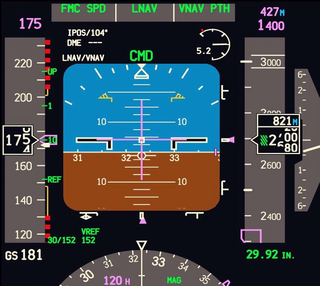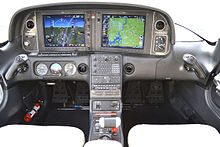
Flight instruments are the instruments in the cockpit of an aircraft that provide the pilot with data about the flight situation of that aircraft, such as altitude, airspeed, vertical speed, heading and much more other crucial information in flight. They improve safety by allowing the pilot to fly the aircraft in level flight, and make turns, without a reference outside the aircraft such as the horizon. Visual flight rules (VFR) require an airspeed indicator, an altimeter, and a compass or other suitable magnetic direction indicator. Instrument flight rules (IFR) additionally require a gyroscopic pitch-bank, direction and rate of turn indicator, plus a slip-skid indicator, adjustable altimeter, and a clock. Flight into instrument meteorological conditions (IMC) require radio navigation instruments for precise takeoffs and landings.

A cockpit or flight deck is the area, on the front part of an aircraft or spacecraft, from which a pilot controls the aircraft.

The attitude indicator (AI), formerly known as the gyro horizon or artificial horizon, is a flight instrument that informs the pilot of the aircraft orientation relative to Earth's horizon, and gives an immediate indication of the smallest orientation change. The miniature aircraft and horizon bar mimic the relationship of the aircraft relative to the actual horizon. It is a primary instrument for flight in instrument meteorological conditions.

A head-up display, or heads-up display, also known as a HUD or head-up guidance system (HGS), is any transparent display that presents data without requiring users to look away from their usual viewpoints. The origin of the name stems from a pilot being able to view information with the head positioned "up" and looking forward, instead of angled down looking at lower instruments. A HUD also has the advantage that the pilot's eyes do not need to refocus to view the outside after looking at the optically nearer instruments.

A multifunction display (MFD) is a small-screen surrounded by multiple soft keys that can be used to display information to the user in numerous configurable ways. MFDs originated in aviation, first in military aircraft, and later were adopted by commercial aircraft, general aviation, automotive use, and shipboard use.

An instrument landing system localizer, or simply localizer, is a system of horizontal guidance in the instrument landing system, which is used to guide aircraft along the axis of the runway.

An engine-indicating and crew-alerting system (EICAS) is an integrated system used in modern aircraft to provide aircraft flight crew with instrumentation and crew annunciations for aircraft engines and other systems. On EICAS equipped aircraft the "recommended remedial action" is called a checklist.

In aviation, an electronic flight instrument system (EFIS) is a flight instrument display system in an aircraft cockpit that displays flight data electronically rather than electromechanically. An EFIS normally consists of a primary flight display (PFD), multi-function display (MFD), and an engine indicating and crew alerting system (EICAS) display. Early EFIS models used cathode ray tube (CRT) displays, but liquid crystal displays (LCD) are now more common. The complex electromechanical attitude director indicator (ADI) and horizontal situation indicator (HSI) were the first candidates for replacement by EFIS. Now, however, few flight deck instruments cannot be replaced by an electronic display.

The Garmin G1000 is an electronic flight instrument system (EFIS) typically composed of two display units, one serving as a primary flight display, and one as a multi-function display. Manufactured by Garmin Aviation, it serves as a replacement for most conventional flight instruments and avionics. Introduced in June 2004, the system has since become one of the most popular integrated glass cockpit solutions for general aviation and business aircraft.

A pitot–static system is a system of pressure-sensitive instruments that is most often used in aviation to determine an aircraft's airspeed, Mach number, altitude, and altitude trend. A pitot–static system generally consists of a pitot tube, a static port, and the pitot–static instruments. Other instruments that might be connected are air data computers, flight data recorders, altitude encoders, cabin pressurization controllers, and various airspeed switches. Errors in pitot–static system readings can be extremely dangerous as the information obtained from the pitot static system, such as altitude, is potentially safety-critical. Several commercial airline disasters have been traced to a failure of the pitot–static system.

A primary flight display or PFD is a modern aircraft instrument dedicated to flight information. Much like multi-function displays, primary flight displays are built around a Liquid-crystal display or CRT display device. Representations of older six pack or "steam gauge" instruments are combined on one compact display, simplifying pilot workflow and streamlining cockpit layouts.

China Airlines Flight 006 was a daily non-stop flight from Taipei to Los Angeles International Airport. On February 19, 1985, the Boeing 747SP operating the flight was involved in an aircraft upset accident, following the failure of the No. 4 engine, while cruising at 41,000 ft (12,500 m). The plane rolled over and plunged 30,000 ft (9,100 m), experiencing high speeds and g-forces before the captain was able to recover from the dive, and then to divert to San Francisco International Airport.
An Air Data Inertial Reference Unit (ADIRU) is a key component of the integrated Air Data Inertial Reference System (ADIRS), which supplies air data and inertial reference information to the pilots' electronic flight instrument system displays as well as other systems on the aircraft such as the engines, autopilot, aircraft flight control system and landing gear systems. An ADIRU acts as a single, fault tolerant source of navigational data for both pilots of an aircraft. It may be complemented by a secondary attitude air data reference unit (SAARU), as in the Boeing 777 design.

An electronic centralised aircraft monitoring (ECAM) or electronic centralized aircraft monitoring is a system that monitors aircraft functions and relays them to the pilots. It also produces messages detailing failures and in certain cases, lists procedures to undertake to correct the problem.

On 15 December 1989, KLM Flight 867, en route from Amsterdam to Narita International Airport Tokyo, was forced to make an emergency landing at Anchorage International Airport, Alaska, when all four engines failed. The Boeing 747-406M, less than six months old at the time, flew through a thick cloud of volcanic ash from Mount Redoubt, which had erupted the day before.

China Airlines Flight 605 was a daily non-stop flight departing from Taipei at 6:30 a.m. and arriving at Kai Tak Airport in Hong Kong at 7:00 a.m. local time. On November 4, 1993, the plane went off the runway and overran while landing during a storm. It was the first hull loss of a Boeing 747-400.

Flight envelope protection is a human machine interface extension of an aircraft's control system that prevents the pilot of an aircraft from making control commands that would force the aircraft to exceed its structural and aerodynamic operating limits. It is used in some form in all modern commercial fly-by-wire aircraft. The professed advantage of flight envelope protection systems is that they restrict a pilot's excessive control inputs, whether in surprise reaction to emergencies or otherwise, from translating into excessive flight control surface movements. Notionally, this allows pilots to react quickly to an emergency while blunting the effect of an excessive control input resulting from "startle," by electronically limiting excessive control surface movements that could over-stress the airframe and endanger the safety of the aircraft.

A flight control mode or flight control law is a computer software algorithm that transforms the movement of the yoke or joystick, made by an aircraft pilot, into movements of the aircraft control surfaces. The control surface movements depend on which of several modes the flight computer is in. In aircraft in which the flight control system is fly-by-wire, the movements the pilot makes to the yoke or joystick in the cockpit, to control the flight, are converted to electronic signals, which are transmitted to the flight control computers that determine how to move each control surface to provide the aircraft movement the pilot ordered.
An integrated standby instrument system (ISIS) is an electronic aircraft instrument. It is intended to serve as backup in case of a failure of the standard glass cockpit instrumentation, allowing pilots to continue to receive key flight-related information. Prior to the use of ISIS, this was performed by individual redundant mechanical instrumentation instead. Such systems have become common to be installed in various types of aircraft, ranging from airliners to helicopters and smaller general aviation aircraft. While it is common for new-built aircraft to be outfitted with ISIS, numerous operators have opted to have their fleets retrofitted with such apparatus as well.

On July 7, 2017, an Airbus A320-211 operating as Air Canada Flight 759 was nearly involved in an accident at San Francisco International Airport in San Mateo County, California, United States. The flight, which originated at Toronto Pearson International Airport, had been cleared by air traffic control to land on runway 28R and was on final approach to land on that runway; however, instead of lining up with the runway, the aircraft had lined up with the parallel taxiway, on which four fully loaded and fueled passenger airplanes were stopped awaiting takeoff clearance. The flight crew initiated a go-around prior to landing, after which it landed on 28R without further incident. The aircraft on the taxiway departed for their intended destinations without further incident. The subsequent investigation by the National Transportation Safety Board (NTSB) determined that the Air Canada airplane descended to 59 feet (18 m) above the ground before it began its climb, and that it missed colliding with one of the aircraft on the taxiway by 14 feet (4.3 m).
























